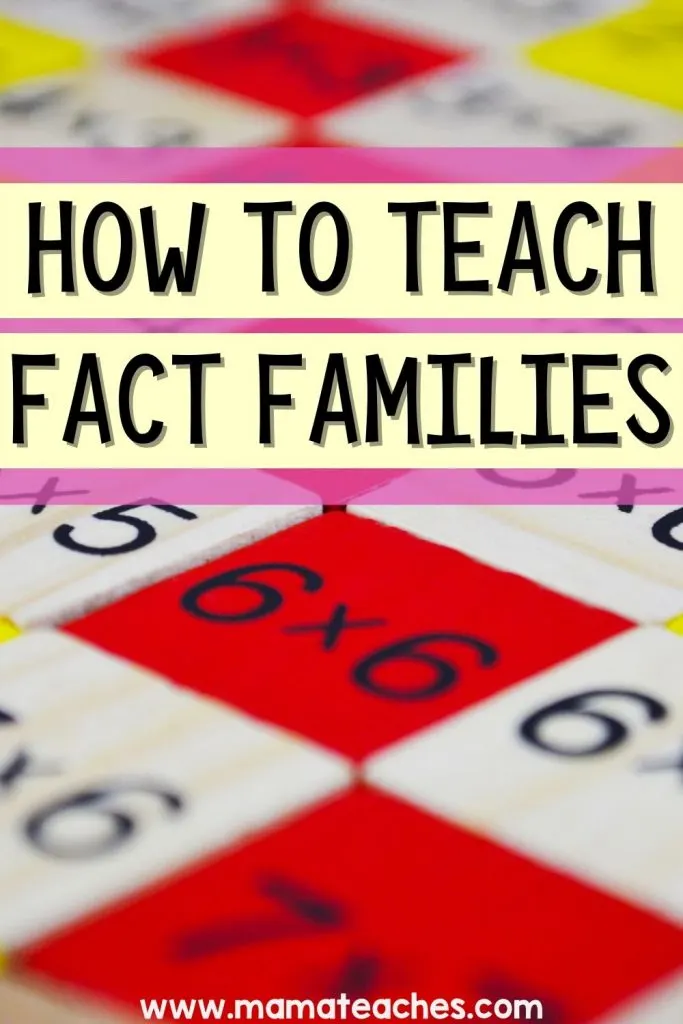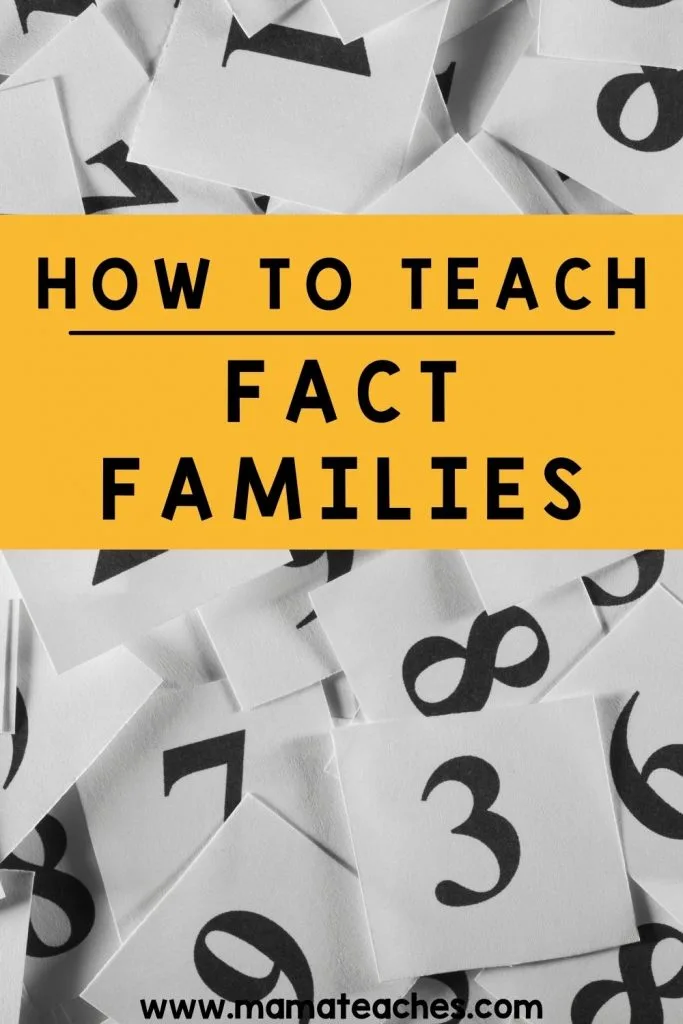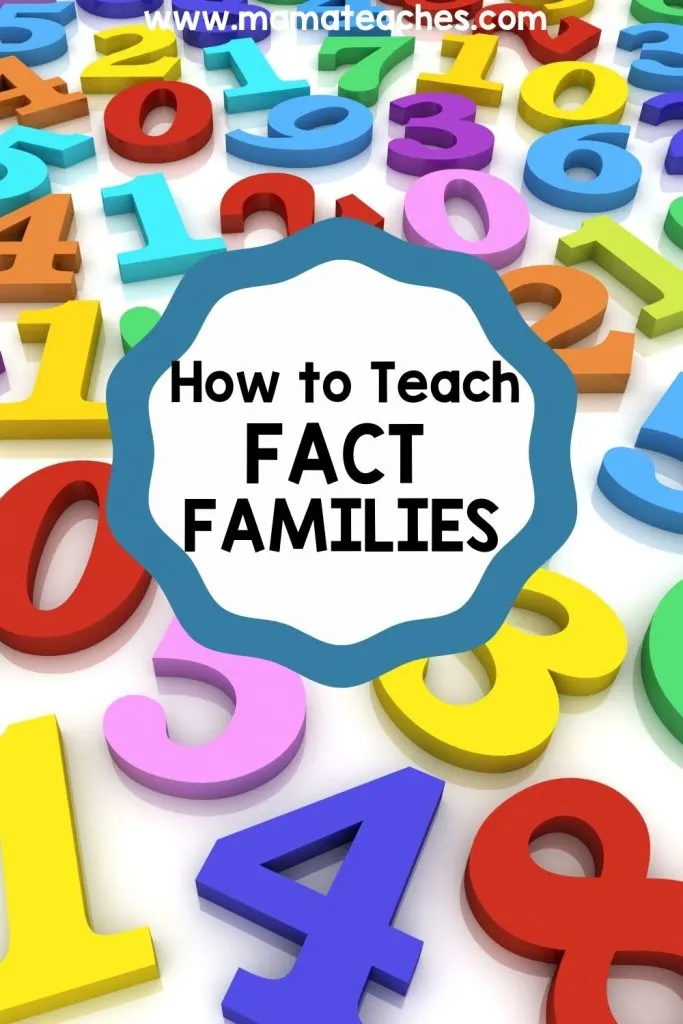Wait…is there an easier way to teach the math facts?
Absolutely!
Get the skinny on fact families and how they can help kids learn their multiplication and division facts.

This article contains affiliate links to things that you might like.
What Are Fact Families?
Fact families are numbers that are related to each other through multiplication and division.
When you have a given multiplication fact like 5 x 6 = 30, there are actually four ways those numbers interact:
5 x 6 = 30
6 x 5 = 30
30 ÷ 6 = 5
30 ÷ 5 = 6
Since multiplication is the opposite of division (mathematicians call it the “inverse operation”), these four facts are all related.
We call them members of the same fact family.
Why Fact Families Help
Fact families help students with learning their multiplication and division facts by cutting down memorization by 75%.
Think about it: you can memorize all four facts separately, or you can learn to recognize the relationship between the three numbers and thus learn 4 facts at once!

How to Teach Fact Families
Fact families make learning multiplication and division facts easier, but they require a mental leap.
Make the concept easier by teaching fact family multiplication and division in a multi-sensory way:
Use Manipulatives
Just like any abstract concept, you need to introduce the idea with something the kids can see and touch.
Start by showing how multiplication facts are related.
Make 2 columns of 6 counters each (I like to use plastic teddy bear counters).
Ask the student to count the bears (12). Then write the multiplication fact: 2 x 6 = 12. Say, “There are two columns of teddy bears with six bears in each column. 2 x 6 = 12”
Then ask the student to look at the bears in a different way.
You can turn them slightly so they look like they are standing in pairs instead of 2 long lines.
Write the multiplication fact 6 x 2 = 12. “Now see that we have 6 small columns of bears with 2 bears in each column. 6 x 2 = 12.
It doesn’t matter if you see it as 2 lines of 6 bears or 6 lines of 2 bears.
Either way, you have 12 bears.”
You can also go through this same process with division.
Start with the same grid of 2 x 6 bears.
“Do you remember how many bears we have?
(12) Can you divide them into 2 equal columns?”
The student will divide the bears into 2 lines of 6.
Write 12 ÷ 2 = 6. “12 bears divided into two equal columns gives you 6 bears in each column.
12 ÷ 2 = 6.” Then put the bears back in their original 2 x 6 grid.
“Can you divide the bears into 6 equal columns?”
Write 12 ÷ 6 = 2. “12 bears divided into 6 equal columns gives you 2 bears in each column. 12 ÷ 6 = 2.”

Group Them Visually
Draw a little house and write the fact family inside the house.
You can even color the houses to make them visually distinct from one another.
These houses serve as flashcards.
For example, one house would be:
6 x 2 = 12 12 ÷ 2 = 6
2 x 6 = 12 12 ÷ 6 = 2
Ask the student to note any patterns.
How many multiplication facts are there?
How many division facts?
Do you notice how the multiplication facts end?
(Always with the biggest number).
How do the division facts start?
(Always with the biggest number)
You can even use your hand or a small index card to cover one of the facts.
Can the student tell which one is missing?
This may take some time to click, but it will happen.
Group the Families
Once your student has been introduced to fact families, you can play games where they need to group the facts by family (put them in their house together).
In this case, you can have the facts already written out on slips of paper.

Fill in the Family
You can also use writing to teach fact families by having the student fill in the blanks.
You provide the related numbers: 2, 6, 12. Then the student plugs them into a fact family template:
___ x ___ = ___ ___ ÷ ___ = ___
___ x ___ = ___ ___ ÷ ___ = ___
Teaching Multiplication and Division Fact Families
Fact families are a concept that once grasped, can make multiplication and division facts much easier to learn.
It can even lay the foundation for algebraic thinking.
Help your student’s “math mindedness” by teaching multiplication and division fact families.
